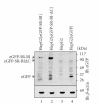Modulators of Protein Kinase C Affect SR-BI-Dependent HDL Lipid Uptake in Transfected HepG2 Cells
- PMID: 21490774
- PMCID: PMC3065880
- DOI: 10.1155/2011/687939
Modulators of Protein Kinase C Affect SR-BI-Dependent HDL Lipid Uptake in Transfected HepG2 Cells
Abstract
SR-BI is a cell surface HDL receptor that mediates selective uptake of the lipid cargo of HDL, an important process in hepatocytes, driving reverse cholesterol transport from cells in the artery wall. To facilitate examination of factors that modulate SR-BI activity in hepatocytes, we have generated fluorescent protein-tagged versions of SR-BI that allow for facile monitoring of SR-BI protein levels and distribution in transfected cells. We show that deletion of the C-terminal cytosolic tail does not affect the distribution of SR-BI in HepG2 cells, nor is the C-terminal cytosolic tail required for SR-BI-mediated uptake of HDL lipids. We also demonstrate that the phorbol ester, PMA, increased, while protein kinase C inhibitors reduced SR-BI-mediated HDL lipid uptake in HepG2 cells. These data suggest that protein kinase C may modulate selective uptake of HDL lipids including cholesterol in hepatocytes, thereby influencing hepatic HDL cholesterol clearance and reverse cholesterol transport.
Figures







Similar articles
-
Phosphatidylinositol-3-kinase regulates scavenger receptor class B type I subcellular localization and selective lipid uptake in hepatocytes.Arterioscler Thromb Vasc Biol. 2006 Sep;26(9):2125-31. doi: 10.1161/01.ATV.0000233335.26362.37. Epub 2006 Jun 22. Arterioscler Thromb Vasc Biol. 2006. PMID: 16794223
-
MicroRNA-24 aggravates atherosclerosis by inhibiting selective lipid uptake from HDL cholesterol via the post-transcriptional repression of scavenger receptor class B type I.Atherosclerosis. 2018 Mar;270:57-67. doi: 10.1016/j.atherosclerosis.2018.01.045. Epub 2018 Feb 4. Atherosclerosis. 2018. PMID: 29407889
-
Increased apolipoprotein M induced by lack of scavenger receptor BI is not activated via HDL-mediated cholesterol uptake in hepatocytes.Lipids Health Dis. 2018 Aug 25;17(1):200. doi: 10.1186/s12944-018-0849-7. Lipids Health Dis. 2018. PMID: 30144814 Free PMC article.
-
Scavenger receptor BI: a multi-purpose player in cholesterol and steroid metabolism.World J Gastroenterol. 2010 Dec 21;16(47):5916-24. doi: 10.3748/wjg.v16.i47.5916. World J Gastroenterol. 2010. PMID: 21157967 Free PMC article. Review.
-
Advanced glycation end products (AGE) inhibit scavenger receptor class B type I-mediated reverse cholesterol transport: a new crossroad of AGE to cholesterol metabolism.J Atheroscler Thromb. 2003;10(1):1-6. doi: 10.5551/jat.10.1. J Atheroscler Thromb. 2003. PMID: 12621157 Review.
Cited by
-
PKCβ: Expanding role in hepatic adaptation of cholesterol homeostasis to dietary fat/cholesterol.Am J Physiol Gastrointest Liver Physiol. 2017 Mar 1;312(3):G266-G273. doi: 10.1152/ajpgi.00373.2016. Epub 2017 Jan 19. Am J Physiol Gastrointest Liver Physiol. 2017. PMID: 28104587 Free PMC article. Review.
-
Functionally defective high-density lipoprotein and paraoxonase: a couple for endothelial dysfunction in atherosclerosis.Cholesterol. 2013;2013:792090. doi: 10.1155/2013/792090. Epub 2013 Oct 7. Cholesterol. 2013. PMID: 24222847 Free PMC article. Review.
-
High density lipoprotein stimulated migration of macrophages depends on the scavenger receptor class B, type I, PDZK1 and Akt1 and is blocked by sphingosine 1 phosphate receptor antagonists.PLoS One. 2014 Sep 4;9(9):e106487. doi: 10.1371/journal.pone.0106487. eCollection 2014. PLoS One. 2014. PMID: 25188469 Free PMC article.
-
Anticipatory role of high density lipoprotein and endothelial dysfunction: an overview.Open Biochem J. 2014 Dec 31;8:100-6. doi: 10.2174/1874091X01408010100. eCollection 2014. Open Biochem J. 2014. PMID: 25598849 Free PMC article.
References
-
- Acton S, Rigotti A, Landschulz KT, Xu S, Hobbs HH, Kriegert M. Identification of scavenger receptor SR-BI as a high density lipoprotein receptor. Science. 1996;271(5248):518–520. - PubMed
-
- Glass C, Pittman RC, Weinstein DB, Steinberg D. Dissociation of tissue uptake of cholesterol ester from that of apoprotein A-I of rat plasma high density lipoprotein: selective delivery of cholesterol ester to liver, adrenal, and gonad. Proceedings of the National Academy of Sciences of the United States of America. 1983;80(17):5435–5439. - PMC - PubMed
-
- Glomset JA. High-density lipoproteins in human health and disease. Advances in Internal Medicine. 1980;25:91–116. - PubMed
-
- Krieger M. Charting the fate of the ’good cholesterol’: identification and characterization of the high-density lipoprotein receptor SR-BI. Annual Review of Biochemistry. 1999;68:523–558. - PubMed
-
- Rigotti A, Trigatti BL, Penman M, Rayburn H, Herz J, Krieger M. A targeted mutation in the murine gene encoding the high density lipoprotein (HDL) receptor scavenger receptor class B type I reveals its key role in HDL metabolism. Proceedings of the National Academy of Sciences of the United States of America. 1997;94(23):12610–12615. - PMC - PubMed
LinkOut - more resources
Full Text Sources
Research Materials

